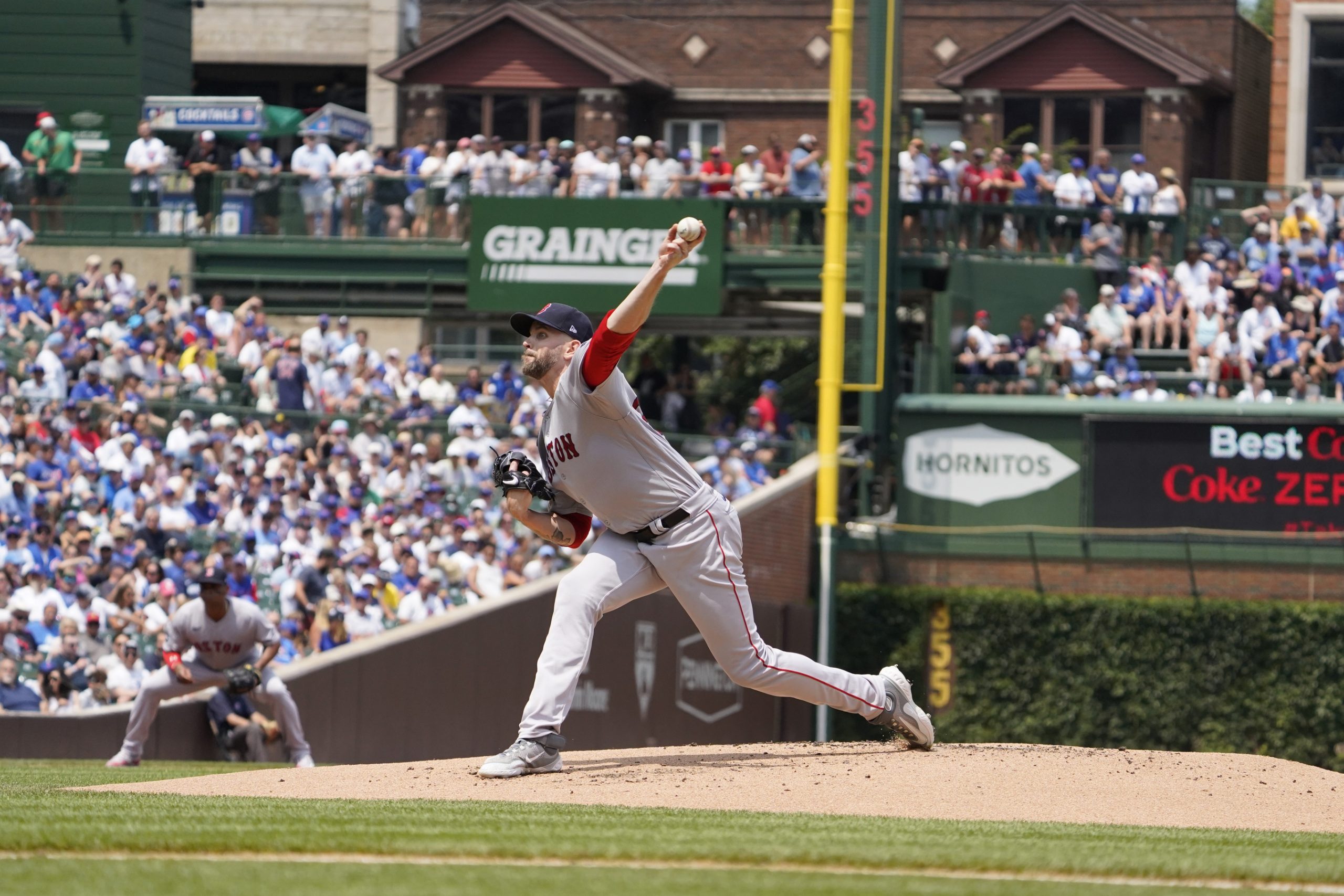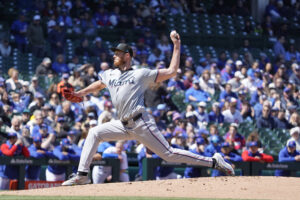Welcome to the fantasy baseball pitching report for the weekend of July 15th and 16th, where we dive into the fascinating world of baseball’s most captivating element: pitching. Each day, we document intriguing patterns and metrics, such as spin rate, velocity, and pitch mix that presented themselves throughout the previous day. But we don’t stop there. Our reports go beyond the numbers, offering fantasy analysis when certain pitchers deserve more or less attention. Whether you’re seeking a competitive edge, the next breakout star, or daily pitching refreshers, these reports have you covered.
Weekend Fantasy Baseball Pitcher Report for July 15th & 16th
James Paxton (3 IP, 3 H, 6 ER, 3 BB, 4 K, 63 Pitches)
James Paxton was cooked by the Cubs on Saturday. The 34-year-old Canadian surrendered a colossal 96.8 mph average exit velocity across his three pitches. Cubs batters were swinging far less than average at Paxton’s secondary pitches when they were out of the zone. His cutter and curveball have averaged out-of-zone swing percentages of 41.7% and 33.9%, respectively. However, in Saturday’s start, Paxton’s cutter only recorded a figure of 22% while the curveball sat at 20%.
Paxton’s fantasy value is tough to quantify. On the one end, he’s an aging, injury-prone starter in the toughest division in the majors. However, on the other, he is able to completely dominate opposing batters with his elite 28.8% strikeout rate and 1.03 WHIP. It’s worth pointing out that his last five starts have been largely unremarkable. In that span, Paxton sports a lackluster 4.00 ERA, 4.91 FIP, and an 8.00 K/9. Paxton’s flashes of greatness may not be worth the injury risk he carries with him.
"I Just kind of lost the handle and wasn't able to find it and just made mistakes"
James Paxton on his 3rd inning | #RedSox pic.twitter.com/Y3uVrV1pt1
— NESN (@NESN) July 15, 2023
Alec Marsh (6 IP, 5 H, 2 ER, 1 BB, 11 K, 92 Pitches)
What on earth happened here? In Friday’s matchup against the floundering Rays, righty Alec Marsh pitched like a man possessed, managing to somehow strike out 11 Rays batters. Marsh relied heavily on his 4-seam fastball. In what was his third start of the year, he increased the usage of the pitch from 41% in his first two starts to 57% last night. Marsh’s heavily-used fastball was somewhat effective, generating a 31% whiff rate and 31% CSW. Additionally, the pitch generated an excellent 82.9 mph average exit velocity. While the Royals rookie had his curveball working at a 50%+ CSW standard in his previous start, it was far less dominant last night. Instead of finding the zone with the pitch 60.9% of the time, he threw it in the zone 38% of the time and collected only two whiffs.
Overall, it was an excellent start, generating 16 swinging strikes against one of the most dominant offenses in the league this year. With a minimal three-start sample size, that had three very different outings, I don’t quite know what to make of Marsh. I think it would be wise to keep an eye on him just in case anything comes of his team and strikeout potential. It’s worth pointing out that I think Marsh was, at least to some degree, rather lucky in this start. Marsh threw numerous fastballs down the middle and hung a couple of curveballs, yet none of those specific mistakes resulted in the damage in this start. His next start will likely fall against the Tigers on Thursday and should be a viable streaming option.
Alec Marsh is the youngest Kansas City Royal to strike out 11+ batters in a game since Yordano Ventura in 2015!pic.twitter.com/gyKIt07ABo
— Codify (@CodifyBaseball) July 15, 2023
Cole Ragans (5 IP, 4 H, 1 ER, 2 BB, 3 K, 81 Pitches)
While his 4-seamer, and the stat sheet, were nothing to write home about, Cole Ragans’ secondaries were excellent in his Saturday matchup against the Rays. His changeup, curveball, and cutter possessed great CSWs of 40%, 46%, and 38%, respectively. Ragan’s curveball measured slightly differently in this start. According to Baseball Savant, when compared to his season averages, the pitch was thrown 1.2 mph harder, had 168 more RPMs, and lost four inches of vertical break. Fangraphs’ pitch modeling noted a stuff+ increase in the pitch from his season average of 94 to 104. Sadly, after his trade from the Rangers to the Royals, Ragans has certainly lost a huge chunk of his fantasy appeal.
Freddy Peralta (6 IP, 1 H, 0 ER, 2 BB, 6 K, 93 Pitches)
Finally. It’s been far too long since we’ve seen an excellent Freddy Peralta start and it ended up coming on Saturday against the Reds. While he only induced 10 whiffs, he wielded an excellent average exit velocity of 81.1 mph. In his past two starts, Peralta has been throwing his curveball harder and flatter. Against the Reds, the pitch was thrown 3.2 mph faster and had seven fewer inches of vertical break compared to his season averages. The pitch had a 75% whiff rate and a solid 33% CSW. Fangraphs’ stuff+ metrics look at the pitch adjustments positively. Prior to his last two starts, Peralta’s curveball had a disappointing stuff+ rating of 83. After changing the way he threw the pitch, his stuff+ has shot up to a value of 101.
Freddy Peralta's 3Ks in the 3rd pic.twitter.com/rX8bPJqCfJ
— Rob Friedman (@PitchingNinja) July 16, 2023
Pete Fairbanks (1 IP, 1 H, 0 ER, 0 BB, 1 K, 17 Pitches)
En route to his 10th save in 11 opportunities, Fairbanks showcased a sizeable increase in velocity over his season average:
- 4-Seam Fastball: 2.4 mph increase
- Slider: 1.6 mph increase
In his last 11 outings, Fairbanks has only surrendered one earned run.
Dylan Cease (5 IP, 3 H, 1 ER, 3 BB, 6 K, 99 Pitches)
An excellent start for Cease against the absurdly dominant Braves offense. While he lacked efficiency and only managed to go five innings, it’s been a rare sight to see a starting pitcher limit Atlanta to just one run. In addition to throwing five one-run innings, Cease managed to rack up 19 swinging strikes. 10 of the swinging strikes came from Cease’s electric 4-seamer. The 4-seamer, in addition to the slider and the knuckle curve, each showed significant increases in velocity in Sunday’s start:
- 4-Seam Fastball: 1.4 mph increase
- Slider: 2.0 mph increase
- Knuckle Curve: 1.7 mph increase
It’s not out of the realm of possibility that Cease could be a possible buy-low candidate at this point. While his last five starts haven’t been stellar, posting a 4.08, there is reason to believe that he has been unlucky due to a 2.55 FIP and 2.81 xFIP. With his elite 13.19 K/9, it won’t take too much of a drop in ERA to make him one of the best fantasy options again.
Kyle Bradish (7 1/3 IP, 3 H, 0 ER, 1 BB, 8 K, 100 Pitches)
Kyle Bradish had a stellar Sunday outing against the Marlins, throwing 7 1/3 shutout innings with eight strikeouts. Bradish’s pitch mix was diverse and effective, with his slider being the most used pitch at 30%, followed by his four-seamer at 27%, curveball at 18%, sinker at 17%, and changeup at 8%. While only working nine whiffs, Bradish pounded the strike zone as he threw 4/5 pitches as a strike more than 60% of the time. Bradish’s performance was a standout, especially considering the Marlins’ offense has been performing well this season. In fact, in his last five starts, Bradish possesses an outstanding 1.74 ERA and 92.7% left-on-base percentage.
On the back of Kyle Bradish, the @Orioles fly to a series sweep and their 8th consecutive win. pic.twitter.com/KH6w5cTFcM
— MLB (@MLB) July 16, 2023
With Bradish’s success, there is a definite sell-high scenario right now. Unless we are witnessing the true birth of a star, he will not be able to maintain his 3.05 seasonal ERA. Despite this, I am not going to be selling my shares of him. If whatever reason Bradish is not rostered in your fantasy league, take the bullet. His ability to rack up wins on one of the best teams in baseball while maintaining a solid K/BB ratio gives him a unique set of values few pitchers have. With the Orioles pushing to overtake the Rays for the top position in the AL East, Bradish has every reason to try to maintain his amazing first half of the season. I had picked Bradish to be one of my three underrated pitchers for the remainder of the campaign.
Bobby Miller (4 2/3 IP, 3 H, 1 ER, 1 BB, 5 K, 77 Pitches)
Meh. There is no doubt that Bobby Miller has the stuff to be an elite pitcher for years to come; however, he’s struggled to put it all together in his rookie season with the Dodgers. Miller really leaned on the fastball in this start, throwing it 42% of the time, much higher than his season average of 16%. Despite possessing one of the hardest fastballs in the majors, it’s just not missing bats at the rate one might think it should. Tonight, for example, the pitch only managed to amass two whiffs on 13 swings. While his seasonal 11.3% swinging strike rate isn’t horrible, it seems too low for an often triple-digit fastball. With that being said, it’s worth noting that 3/5 of his pitches suffered significant drops in velocity tonight against the Mets:
- 4-Seam Fastball: 1.1 mph decrease
- Curveball: 1.6 mph decrease
- Slider: 2.4 mph decrease
Sunday’s start marks the fifth consecutive start where Miller has not been able to make it six innings. In that period of time, Miller holds an abysmal ERA of 6.23. With that being said, I can’t look past Miller’s raw talent. If I had to put a tag on the Dodgers rookie I would have to call him a potential buy-low pitcher for the second half of the season. His value, especially in re-draft leagues, will be at an all-time low and will cost you pennies on the dollar when compared to his first five starts of the campaign. Obviously, there is a level of risk that comes along with buying an inexperienced, and struggling, pitcher but I have full faith in the Dodgers organization’s elite pitcher development program.
Reese Olson (5 1/3 IP, 6 H, 2 ER, 0 BB, 5 K, 75 Pitches)
The baseball world heavily underrates Reese Olson and it’s difficult for me to understand how Olson is not a lock for a spot in the Tigers’ starting rotation. In his Sunday night start against the Mariners, the rookie showcased his ability to miss bats with his slider and 4-seamer accumulating 14 whiffs on 56 pitches between the two pitches. Unsurprisingly, the two pitches also commended elite CSW% values in this start with the slider sitting at 45% and the 4-seamer at 36%. Unless you’ve been following Olson and the Tigers you likely are unaware that he possesses an elite slider. In fact prior to this start, according to Pitcher List, the pitch ranks in the 96th percentile for CSW%, 91st percentile in xAVG, and 90th percentile for AVG and BABIP. To add to this, Olson’s slider also has the highest spin rate in the majors at 3033 RPMs.
At this point, Olson is only rostered in seven percent of Yahoo fantasy leagues and is very likely to be still available in your league. While I cannot say that he is a must-add in all fantasy formats, everyone reading this report should be keeping an eye out for him and his next starts. While not every fantasy manager may be able to justify adding him permanently, he should absolutely be considered to be a valid streamer option when the matchup is right.
Reese Olson, Wicked 84mph Slider. 🤢 pic.twitter.com/FQ9JjQORxA
— Rob Friedman (@PitchingNinja) July 16, 2023
Main photo credits:
David Banks-USA TODAY Sports
Players mentioned:
James Paxton, Alec Marsh, Cole Ragans, Freddy Peralta, Pete Fairbanks, Dylan Cease, Kyle Bradish, Bobby Miller, Reese Olson






